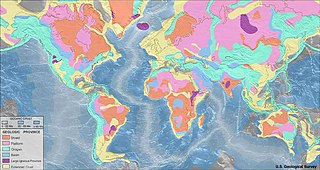 W
WThe Cretaceous–Paleogene (K–Pg) extinction event, also known as the Cretaceous–Tertiary (K–T) extinction, was a sudden mass extinction of three-quarters of the plant and animal species on Earth, approximately 66 million years ago. With the exception of some ectothermic species such as the sea turtles and crocodilians, no tetrapods weighing more than 25 kilograms survived. It marked the end of the Cretaceous period, and with it the end of the entire Mesozoic Era, opening the Cenozoic Era that continues today.
 W
WCore–mantle differentiation is the set of processes that took place during the accretion stage of Earth's evolution that results in the separation of iron-rich materials that eventually would conform a metal core, surrounded by a rocky mantle. According to the Safronov's model, protoplanets formed as the result of collisions of smaller bodies (planetesimals), which previously condensed from solid debris present in the original nebula. Planetesimals contained iron and silicates either already differentiated or mixed together. Either way, after impacting the Proto-Earth their materials very likely became homogenized. At this stage, the Proto-Earth was probably the size of Mars. Next followed the separation and stratification of the Proto-Earth's constituents, chiefly driven by their density contrasts. Factors such as pressure, temperature, and impact bodies in the primordial magma ocean were involved in the differentiation process.
 W
WThe Cretaceous–Paleogene (K–Pg) extinction event, also known as the Cretaceous–Tertiary (K–T) extinction, was a sudden mass extinction of three-quarters of the plant and animal species on Earth, approximately 66 million years ago. With the exception of some ectothermic species such as the sea turtles and crocodilians, no tetrapods weighing more than 25 kilograms survived. It marked the end of the Cretaceous period, and with it the end of the entire Mesozoic Era, opening the Cenozoic Era that continues today.
 W
WThe Great Oxidation Event (GOE), sometimes also called the Great Oxygenation Event, Oxygen Catastrophe, Oxygen Crisis, Oxygen Holocaust, or Oxygen Revolution, was a time period when the Earth's atmosphere and the shallow ocean first experienced a rise in oxygen, approximately 2.4 - 2.0 Ga (billion years ago) during the Paleoproterozoic era. Geological, isotopic, and chemical evidence suggest that biologically produced molecular oxygen (dioxygen, O2) started to accumulate in Earth's atmosphere and changed it from a weakly reducing atmosphere to an oxidizing atmosphere, causing many existing species on Earth to die out. The cyanobacteria producing the oxygen caused the event which enabled the subsequent development of multicellular forms.
 W
WThe Late Heavy Bombardment (LHB), or lunar cataclysm, is a hypothesized event thought to have occurred approximately 4.1 to 3.8 billion years (Ga) ago, at a time corresponding to the Neohadean and Eoarchean eras on Earth. During this interval, a disproportionately large number of asteroids are theorized to have collided with the early terrestrial planets in the inner Solar System, including Mercury, Venus, Earth and Mars. Since 2018, the existence of the Late Heavy Bombardment has been questioned.
 W
WIn a volcanic eruption, lava, volcanic bombs and ash, and various gases are expelled from a volcanic vent and fissure. While many eruptions only pose dangers to the immediately surrounding area, Earth's largest eruptions can have a major regional or even global impact, with some affecting the climate and contributing to mass extinctions. Volcanic eruptions can generally be characterized as either explosive eruptions, sudden ejections of rock and ash, or effusive eruptions, relatively gentle outpourings of lava. A separate list is given below for each type.
 W
WThe following is a list of known orogenies organised by continent, starting with the oldest at the top. The organization of this article is along present-day continents that do not necessarily reflect the geography contemporary to the orogenies. Note that some orogenies encompass more than one continent and might have different names in each continent. Likewise some very large orogenies include a number of sub-orogenies. As with other geological phenomena orogenies are often subject to different and changing interpretations regarding to their age, type and associated paleogeography.
 W
WThe following is a list of sinkholes, blue holes, dolines, crown holes cenotes, and pit caves. A sinkhole is a depression or hole in the ground caused by some form of collapse of the surface layer. Some are caused by karst processes—for example, the chemical dissolution of carbonate rocks or suffosion processes. Sinkholes vary in size from 1 to 600 m both in diameter and depth, and vary in form from soil-lined bowls to bedrock-edged chasms. Sinkholes may form gradually or suddenly, and are found worldwide.
 W
WThe Ouachita orogeny was a mountain building event that resulted in the folding and faulting of strata currently exposed in the Ouachita Mountains. The more extensive Ouachita system extends from the current range in Arkansas and Oklahoma southeast to the Black Warrior Basin in Alabama and to the southwest through the Llano, Marathon, and Solitario uplifts in Texas on into Coahuila and Chihuahua in Mexico.
 W
WThis timeline of volcanism on Earth includes a list of major volcanic eruptions of approximately at least magnitude 6 on the Volcanic Explosivity Index (VEI) or equivalent sulfur dioxide emission during the Quaternary period. Other volcanic eruptions are also listed.